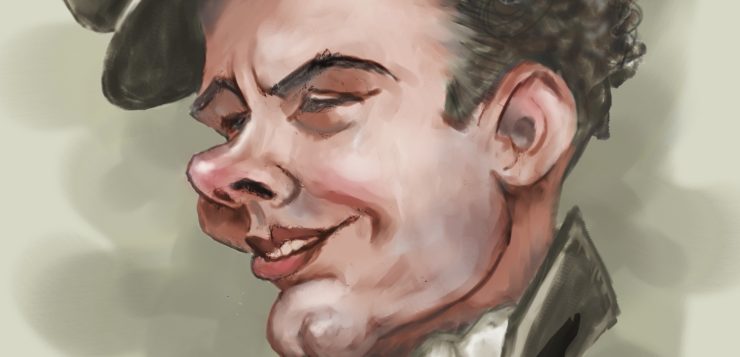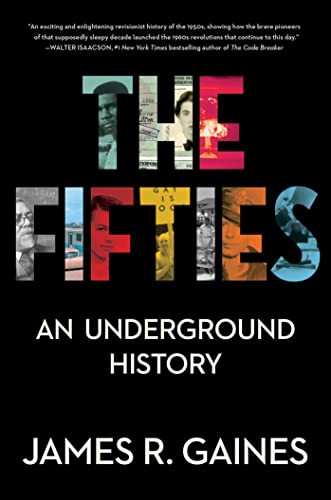IT HAS BEEN almost thirty years since David Halberstam published The Fifties, a highly readable portrait of a dreamily hopeful and brutally discriminatory decade. Now comes a new book, a compact “underground history” of this era of postwar contradictions. The former managing editor of Time magazine and author of several previous books, James R. Gaines argues that gay liberation and three other social movements took hold in the 1950s, thanks to activists who refused to lie back and let a rapacious decade have its way with them.
Each chapter introduces a movement through the lives of several figures whose contributions have mostly slipped through the sieve of our nation’s short memory. In his chapter on gay rights, Gaines tells the stories of Harry Hay and Frank Kameny, leaders of the Mattachine Society. The chapter on feminism chronicles the careers of legal scholar Pauli Murray, women’s studies founder Gerda Lerner, and civil rights activist Fannie Lou Hamer. The civil rights chapter weaves together the stories of Black veterans who became activists, primarily Medgar Evers and Robert F. Williams, and the closing chapter on ecology, in an unusual pairing, links environmentalist Rachel Carson, author of Silent Spring, with MIT mathematician-philosopher Norbert Wiener, author of The Human Use of Human Beings.
In his introduction, Gaines cites the theory that “change happens not by winning hearts and minds but by changing the law, after which hearts and minds will follow.” But, as his book demonstrates, “there is an earlier moment in the process of change, when a few variously driven people set out to win over the hearts and minds of those who make the laws. Though isolated by their personal histories, idiosyncrasies, and gifts, they have in common a need, a vision, and the blind courage to fight for change in their time and for the future.”
 That is certainly true of Harry Hay, the son of a privileged English family, who grew up in California and spent most of his life there. By the time he founded the Mattachine Society in Los Angeles in 1950, he was a married man, a father of two adopted daughters, and an active member of the Communist Party USA. More than ready for a fresh start, Hay left the homophobic CPUSA and a dishonest marriage to concentrate on the nascent gay rights organization. Looking back on its early years, he remarked: “[T]here were no guideposts to go by. We felt we couldn’t make a mistake, because if we did, we might possibly deter the movement from developing for years to come. After all, we were facing McCarthyism. … So we operated by unanimity, which meant, among other things, the meetings over weekends would often last sixteen to eighteen hours.”
That is certainly true of Harry Hay, the son of a privileged English family, who grew up in California and spent most of his life there. By the time he founded the Mattachine Society in Los Angeles in 1950, he was a married man, a father of two adopted daughters, and an active member of the Communist Party USA. More than ready for a fresh start, Hay left the homophobic CPUSA and a dishonest marriage to concentrate on the nascent gay rights organization. Looking back on its early years, he remarked: “[T]here were no guideposts to go by. We felt we couldn’t make a mistake, because if we did, we might possibly deter the movement from developing for years to come. After all, we were facing McCarthyism. … So we operated by unanimity, which meant, among other things, the meetings over weekends would often last sixteen to eighteen hours.”
In the beginning, the society was divided into local groups, somewhat like communist cells, that had little contact with each other as a means of self-protection. An early mission statement declared that the organization would help its members stop being “bewildered, unhappy, alone, isolated from their own kind and unable to adjust to the dominant culture.” The society also sought to expand the literature on homosexuality and do what it could to “erase from our law books the discriminatory and oppressive legislation presently directed against the homosexual minority.”
As so often happens when a new organization’s goals are unassailably noble, discord broke out quickly. Mattachine’s flamboyant “street queens” were louder and prouder than the pinstriped conservatives, who were all about playing it safe. Hay was in the bolder group, though his comments don’t sound all that radical now: “We were talking about the right to self-respect … and to appreciate that we are strong, not weak people—that a sissy means a stubborn person who’s put up with an awful lot of stuff and who comes through being exactly what he is.”
But Hay was off and running, no matter who was or wasn’t following him. Gaines describes how Hay helped his friend Dale Jennings beat a “vag-lewd” (vagrancy-lewd) charge in L.A.—an early success that encouraged the founding of numerous Mattachine Society groups across California. In 1953, the society’s first convention drew a crowd of 150 to 200 people, which caused Hay to exult in retrospect: “[Y]ou looked up and all of a sudden the room became vast—well, you know, was there anybody in Los Angeles who wasn’t gay? We’d never seen so many people.”
Alas, the meeting exposed the rift within the group when founding member Chuck Rowland, the principle author of the society’s proposed constitution, addressed the crowd. Rowland buoyantly predicted a future “when we will march arm in arm, ten abreast down Hollywood Boulevard proclaiming our pride in our homosexuality.” The audience’s response? Gay crickets. “People were more in shock than anything else,” Rowland recalled. “One of my friends in Mattachine said he almost had a coronary at such an outrageous thought.”
During that fateful convention, Gaines writes, word arrived “that a Senate committee was scheduling hearings in L.A. to investigate nonprofit advocates for left-wing causes, and the double trouble of former communists leading a gay-activist society could make it a very large target.” With that, Hay and the other founders realized they had to step down. The conservative element took over and the Mattachine Society brought in “sexologists, psychologists, and psychiatrists” who pathologized gay men and snuffed out the stirrings of self-respect that Hay had tried so hard to promulgate. After the disastrous convention, Hay “seemed to disappear” from activist circles for a time. Likewise he disappears from Gaines’ discussion until returning for a bow in the chapter’s closing pages.
Throughout the book, just as I became invested in one valiant figure’s life and travails, that person would drop out and another would pop up. So it was when Hay exited and Frank Kameny arose. I was interested in Kameny’s brilliant academic career, his military service, his determined restart of the Mattachine Society, and the public recognition he received late in life, but I wondered what happened to Harry Hay. We later learn in a passing comment that Hay went on to cofound the Radical Faeries, “an anarchistic, communitarian, back-to-the-land movement,” in the late 1970s.
I found this book frustrating in other ways. More than once, I flipped pages back and forth in search of key dates, only to find that they weren’t provided, and the narrative in any given chapter does not hew closely to chronological order. In a book about the history of a certain era, dates and the sequence of events are paramount.
However, The Fifties does vividly remind us that the brave activists chronicled in this book started out as preternaturally smart, motivated young people with a broad streak of wildcat in them. Now that the 2020s are emerging as a vicious decade drenched in all manner of hate, we can take a cue from this earlier time. In the face of political oppression and draconian laws, these activists read everything, networked endlessly, protected each other, and then pounced when the time felt right. As Gaines writes on the last page of his book, “[T]hey accomplished what few of us can claim and more than we could ask of them: a little more distance down the path to a less imperfect union.”
Hilary Holladay is the author of The Power of Adrienne Rich: A Biography.







